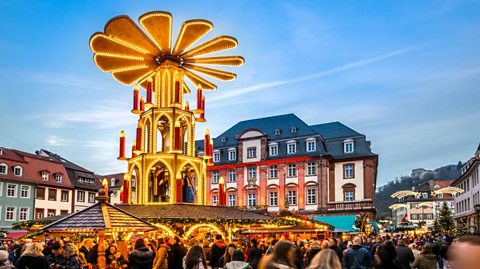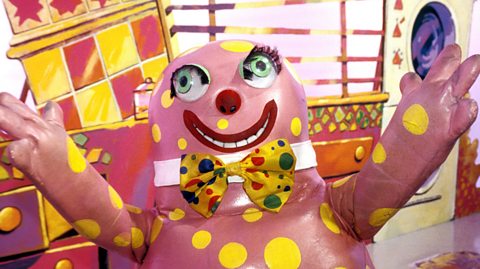Have you ever wondered what makes Christmas so Christmassy?
You can probably list off all the traditions when you think of a British Christmas. But where did they come from and why did they stick around? Here are five Christmas mysteries unwrapped.

Why is there dried fruit in everything?
Mince pies, Christmas cake, Christmas pudding we all love - or loathe - that fruit and spices taste. But why are all the seasonal treats stuffed with dried fruit?
A similar recipe for Christmas cake dates (ba-dum tss) all the way back to Roman times: the Romans made satura, as part of Saturnalia, the Roman celebration of winter solstice. Satura is a heavy cake made with fruit, nuts and honey. Citrus fruits in particular were a huge status symbol and honey is a natural preservative, so itÔÇÖs thought that this was the Roman method of preserving fruit through the winter (as well as showing off how fancy you were).
This sugary recipe spread to parts of medieval Europe. A medieval porridge known as ÔÇÿfrumentyÔÇÖ started as a fasting meal in preparation for the Christmas festivities. Frumenty had a long shelf-life as currants, raisins, prunes, spices and wine preserved the beef and mutton in it. This recipe shifted from savoury to a sweet dessert known as plum pudding leading up to the 19th Century - there were still no actual plums, however, as the word ÔÇÿplumÔÇÖ used to refer to prunes or dried fruit in general.
Fruit and spices became more accessible in the Victorian era, and puds became less about preservation and more about custom. Plum pudding finally became the iconic sticky dome we know and eat today and was traditionally made with 13 ingredients to represent Jesus and his disciples. The high sugar and brandy content meant that they could keep all the way through Advent - in fact, it could be made weeks in advance on Stir-up Sunday. It remained a Victorian Christmas must.
As for mince pies, the story is very similar. Meat (usually lamb or mutton) was mixed with spices and fruit in order to be preserved inside ÔÇÿpyesÔÇÖ or ÔÇÿcoffynsÔÇÖ, but the meaty bits fell out of fashion in the Victorian era. The new concoction of orange zest, suet, fruit and spices wouldnÔÇÖt expire as quickly as a meaty mix would, so pies could be stocked and stored for the perfect Christmas party.

Why are Christmas crackers shaped like giant sweets?
When youÔÇÖre groaning at a dodgy pun over your turkey dinner, raise a toast to Tom Smith.
HeÔÇÖs the man seen by many as the inventor of the Christmas cracker. In 1847 he was based in London in the confectionery trade, known best for his French bonbon, a sweet wrapped in paper that was fastened with a twist at either end.
With SmithÔÇÖs rivals soon copying his bonbon success, he had to find another way to stand out. That led to bigger packaging and the addition of a romantic message within. Eventually, the bonbon was dropped altogether and a token put in its place, leading to something which seems very much like the Christmas crackers we have today.

It took a while before crackers snapped. Apparently inspired by the crackling sound of a festive log fire, the bangers which could make the desired sound, via the chemical compound of silver fulminate, already existed and were added to the packaging. The paper hat? That was introduced later by SmithÔÇÖs son, Walter.
In every origin story, there is usually a counter claim. There remains some dispute over Tom Smith being the true inventor of the Christmas cracker. Another London-based confectionery firm, owned by the Italian businessman Gaudente Sparagnapane, claims to be the oldest cracker manufacturer in Britain, beginning operations in 1846, a year before Tom Smith.
Why do we have Christmas markets?

Many Christmas traditions we celebrate in the UK are thanks to Germany. These include advent calendars, Christmas trees and (you guessed it) Christmas markets.
Back in medieval times, Vienna, Austria, had a Dezembermarkt (December market), which may have been the precursor to German Christmas markets. Shopkeepers were allowed to hold a market for a day or two in early winter so townspeople could stock up on supplies for the colder months.
Then Wintermärkte (winter markets) became a custom all over Europe. Treats such as roasted nuts and gingerbread were sold, as well as toys and decorations to give away as presents at Christmas. Eventually the markets became known as Weinachtsmärkte (Christmas markets), with some sources claiming the earliest to have been held in what is now Berlin in 1310.
Christmas markets came to the UK, US and Canada fairly recently, with the first in the UK being in Lincoln, 1982. While traders in any Christmas market are from all over the world, German staples such as Bratwurst, Lebkuchen, Gl├╝hwein and Stollen are what we associate with Christmas markets today.

Why do we decorate trees with tinsel and baubles?
Another German invention, tinsel dates back to Nuremberg in 1610. Christmas trees used to be decorated with real candles (really not advised) and tinsel was made from shredded silver to reflect the candlelight. Silver was very expensive, so sparkly tinsel-wrapped trees were a sign of wealth.
Eventually, tinsel was made with cheaper metals such as copper and tin. ItÔÇÖs not clear exactly when tinsel came to Britain, but the Christmas tree itself was introduced to the UK by Queen VictoriaÔÇÖs German-born husband Prince Albert. Christmas trees would be hung from the ceiling or placed on tables and decorated with nuts, fruits, sweets, homemade decorations and small presents. However, there is no evidence of tinsel on Queen VicÔÇÖs tree, so it might have been picked up as a tradition after her reign.
Baubles were first invented in Lauscha, Germany, by a glassblower called Hans Greiner in the 16th Century. Hans couldnÔÇÖt afford apples to decorate his tree, so he made his own. Fruit and nut-shaped glass became an accessible Christmas tree decoration, and glassblowers started to make all sorts of shapes, including the spheres we think of today. Prince Albert also brought baubles over to the UK in the 1840s, and Lauscha began exporting them across Europe and America.
Tinsel and baubles are now made from a shiny plastic called PVC, which is sustainable but is not always recyclable. For an eco-friendly alternative, why not go back to aluminium tinsel and glass baubles - or keep your decorations to reuse next year instead of buying new.


What does holly symbolise?
Dark green leaves contrasted with the reddest of berry-red berries. Few things make us feel more Christmassy than holly when theyÔÇÖre part of a door wreath, garland, or featured in the design of a festive jumper.
Long before it became so linked with Christmas, holly possessed symbolism and was seen as a lucky charm. Its berries and spikes were considered a sign of masculinity and it had assumed connections with fertility. Holly was also brought indoors to ward off witches and bad spirits, especially in farm buildings where there were fears of losing livestock to a curse.
Christianity embraced holly too. The spiky foliage represents the crown of thorns worn by Jesus Christ at the crucifixion and the berries his blood. Although Christ died at Easter, it became a tradition to bring sprigs into the house at Christmas. It is still considered bad luck to cut down an entire holly tree as superstition dictates a visitation from a nasty element of the spirit world will follow.
The Christmas is coming quiz
Don't panic! It's a test of your Stir-up Sunday and advent knowledge

A bitesize history of Christmas number ones
Come read all about the top of the pops to the top of the flops.

We spoke to Dr Sylvia Knight of the Royal Meteorologist Society to answer six very important cold weather questions.
